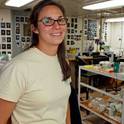
Article
Larvae from deep-sea methane seeps disperse in surface waters
Science Magazine
(2014)
Abstract
Featured ‘Science Shot’ on Science Magazine’s website: http://tinyurl.com/l3dfu4k
Surface currents carry deep-sea larvae thousands of kilometers from where they started. That’s the conclusion of a study published this week in the Proceedings of the Royal Society B, which helps explain how marine communities that depend on isolated methane sources manage to colonize far-flung regions. In the deep ocean, beyond the reach of sunlight, photosynthesis is not possible. Oases of life, however, can form at cold seeps, areas where methane naturally leaks from the sea floor due to large-scale tectonic pressures. Harnessed by chemical-eating bacteria, these seeps can provide a source of energy for a variety of animals—including mussels, snails (pictured), and tubeworms. Some of these species can be found living at seeps on both sides of the Atlantic, despite the fact that deep waters move too slowly for their larvae to survive traveling directly across the ocean. Surface currents, however, move much faster and could potentially carry the larvae across this distance in time. To test the idea, researchers sampled microscopic life from the water column above a cold seep in the Gulf of Mexico. The larvae of two seep-dwellers—a mussel and a small sea snail—were both found in shallow waters. Although these discoveries may explain how such communities spread across the seas, it is still unclear how the larvae eventually succeed in locating a seep once they have returned to the deep. The researchers suggest that the larvae may be able to pick up on environmental clues that tell them if they have managed to find a seep to call home.
Keywords
- Larvae dispersal
Disciplines
Publication Date
2014
Citation Information
Shawn M. Arellano, Ahna L. Van Gaest, Shannon B. Johnson, Robert C. Vrijenhoek, et al.. "Larvae from deep-sea methane seeps disperse in surface waters" Science Magazine (2014) Available at: http://works.bepress.com/shawn-arellano/3/
